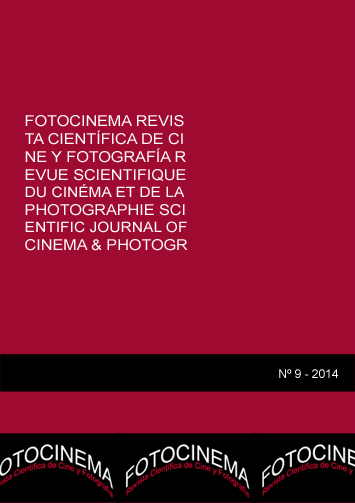Mutaciones digitales del cine documental. Espacio narrativo e interacción en el webdocumental contemporáneo: Prison Valley (Upian/arte, 2010)
DOI:
https://doi.org/10.24310/Fotocinema.2014.v0i9.5960Abstract
El desarrollo actual de las narrativas no lineales multimedia ha propiciado un aumento exponencial de la producción de contenidos documentales interactivos que tratan de explorar las potencialidades expresivas de las herramientas digitales. De entre la avanlacha de proyectos llevados a cabo, con resultados absolutamente divergentes, es necesario reparar en algunos artefactos comunicativos de compleja definición, más conocidos como webdocumentales en los que confluyen elementos procedentes tanto de las narrativas hipertextuales, por un lado, como del cine documental, por otro. La retórica interactiva de estos nuevos productos pretende relatar historias caracterizadas por una creciente y cada vez más desarrollada relación con el usuario, al que asigna un nuevo lugar en la construcción del sentido. La hibridación de formatos y medios inicia el camino para una reflexión metalingüística y política en esta nueva forma audiovisual, que se abre camino muchas veces al margen de la industria, se produce de modo independiente y se dirige a aquellos espectadores dispuestos a emprender una experiencia narrativa activa.Abstract:
The current development of multimedia nonlinear narratives has led to an exponential increase in content production interactive documentaries that try to explore the expressive potential of digital tools. Among the projects avanlache conducted with quite divergent results, it is necessary to notice some definition complex communicative artifacts, better known as webdocumentarys or interactive multimedia documentary, which combines elements from both hypertext narratives, on the one hand such as documentary films, on the other. The rhetoric of these new products interactive storytelling intends characterized by a growing and increasingly developed relationship with the user, which assigns a new place in the construction of meaning. Hybridization of formats and media starts the way for a political metalinguistic consideration in this new audiovisual form, which often finds its way outside the industry, is produced independently and is for those viewers willing to undertake a narrative experience active.
Palabras clave:
Documental; hipertexto; modos de representación; webdocumental; cultura digital.
Keywords:
Documentary, Hipertext, Representation Modes, Webdocumentary, Digital Culture.Downloads
Metrics
Publication Facts
Reviewer profiles N/A
Author statements
Indexed in
-
—
- Academic society
- N/A
- Publisher
- Universidad de Málaga
Downloads
Published
How to Cite
Issue
Section
License
All contents published in Fotocinema Revista científica de cine y fotografía are protected under the Creative Commons Attribution-NonCommercial-ShareAlike 4.0 International (CC BY-NC-SA 4.0) license. All about this license is available in the following link: <http://creativecommons.org/licenses/by-nc-sa/4.0>
Users can copy, use, redistribute, share and exhibit publicly as long as:
- The original source and authorship of the material are cited (Journal, Publisher and URL of the work).
- It is not used for comercial purposes.
- The existence of the license and its especifications are mentioned.
There are two sets of authors’ rights: moral and property rights. Moral rights are perpetual prerogatives, unrenounceable, not-transferable, unalienable, imprescriptible and inembargable. According to authors’ rights legislation, Fotocinema. Revista científica de cine y fotografía recognizes and respects authors moral rights, as well as the ownership of property rights, which will be transferred to University of Malaga in open access. The property rights are referred to the benefits that are gained by the use or the dissemination of works. Fotocinema. Revista científica de cine y fotografía is published in an open access form and it is exclusively licenced by any means for doing or authorising distribution, dissemination, reproduction, , adaptation, translation or arrangement of works.
Authors are responsable for obtaining the necessary permission to use copyrighted images.














13.png)



